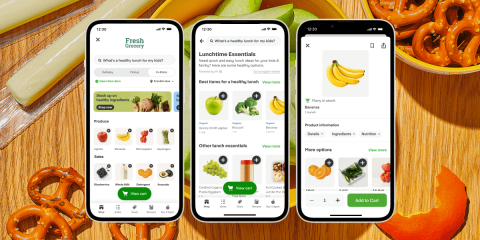Game-Changing Tech Updates at Instacart

There’s been a lot of talk about creating seamless experiences for consumers in the omnichannel. Now, Instacart is walking the walk by connecting digital and in-store shopping through major enhancements to its Instacart Storefront and Caper Cart solutions.
“For the last decade, we’ve been focused on bringing grocers online – and with these latest solutions, we're demonstrating our commitment to delivering an omnichannel retail enablement platform – unifying the online and in-store experience. We’re extending the power of AI to enable personalized shopping experiences for all grocery customers – regardless of whether they’re shopping in-store or online,” David McIntosh, Instacart's VP and general manager of connected stores, told Progressive Grocer.
[Read more: “How Kroger and Instacart Build Ideal Shopper Experiences”]
To McIntosh’s point, the changes take Instacart’s already-sophisticated grocery data to the next level through artificial intelligence (AI). For example, AI-powered conversational search has been added to Instacart's Storefront digital commerce platform. Users can ask questions directly into the search bar on a retailer's storefront and get a fast, accurate answer through the combination of OpenAI’s ChatGPT models and Instacart’s own product data and AI models.
According to McIntosh, the new chat-based search helps shoppers explore a wider range of products from grocers’ catalogs that align with their preferences. “Over time, we believe this will result in larger basket sizes and more engaged customers for the retailers and brands we work with,” he declared.
In his interview with PG, the Instacart exec emphasized the fact that the Storefront feature can benefit – and is being used by – grocers of all sizes and scales. “Instacart Storefront is available in two tiers, enabling grocers of every size to build their online business. Storefront makes it easy for retailers to build e-commerce storefronts quickly and fulfill orders through our shopper community, and Storefront Pro is designed for retailers seeking enterprise-grade customization,” he explained.
Another new Storefront feature is an “In-Store” mode, which helps shoppers at physical stores determine what’s in stock and access important information about items on their shopping list. Customers can also sort items by aisle, find in-store promotions and discounts and get product recommendations. In turn, retailers can leverage the information to better understand their omnichannel shoppers. Early grocery adopters of this capability include Food Bazaar, Gelson’s and Stew Leonard's; the In-Store mode is also being tested in the Instacart app.

Food retailers can also check out new marketing and merchandising capabilities available on the latest version of Instacart Storefront. For instance, they can create shoppable digital flyers and use the self-service feature that allows anyone to become an e-commerce administrator.
In addition to the new Storefront tools, Instacart announced several updates to its Caper Cart, which is a smart cart deployed by retailers like Bristol Farms, Schnucks, ShopRite and Fairway Market. Here, too, AI is a difference-maker, improving the speed and precision of the carts’ cameras and weight sensors. Moreover, customers can now order items like deli trays directly from their cart during their trip to a physical store, thanks to Instacart's FoodStorm order management solution.
Instacart’s team has been busy adding other features to the Caper Cart, like the ability to offer shoppers in-store rewards for completing actions such as adding certain items to the cart, trying the cart for the first time or logging into a loyalty cart. To help retailers manage the carts, the company has created a Caper Cart dock where the carts can be stored and charged in a stacked way.
The tech upgrades come at a pivotal time in the retail season, as grocers ramp up for the holidays. “AI-powered conversational search helps customers plan their holiday meals by surfacing recipes for the whole family and suggestions for when you need one more dish on the table. In-Store mode helps people move through their holiday shop faster than ever, ensuring they don’t forget anything on their list, and that specific ingredients – like canned pumpkin for Thanksgiving pie – are in stock at their local grocer,” noted McIntosh. “With Caper Carts, we’re enabling customers to skip the line and order their prepared foods and baked goods directly from the cart with our new FoodStorm integration, in turn helping retailers promote their unique prepared food offerings. We’re excited to make these capabilities available just in time for the holidays.”
In other news, Instacart shared this week that it has added a new Instacart for Shopify app that allows CPG brands on Shopify to access Instacart Ads. The app helps merchants track their overall sales on Instacart, create an Instacart Ads manager account and view high-level ads performance metrics.
Indeed, it’s been a high-profile time for Instacart, which filed for a proposed IPO on Aug. 25. In its filing, the grocery tech company underscored the point that it has been profitable for five straight quarters and shared that CPG heavy-hitter PepsiCo has agreed to purchase $175 million of its stock.
San Francisco-based Instacart partners with more than 1,400 national, regional and local retail banners to deliver from 80,000-plus stores across more than 14,000 cities in North America.







